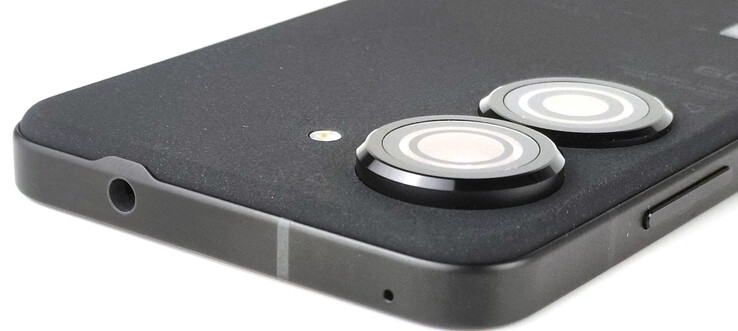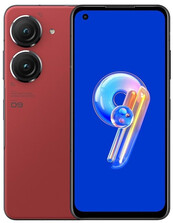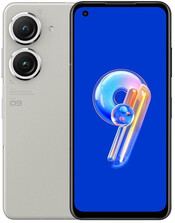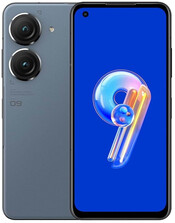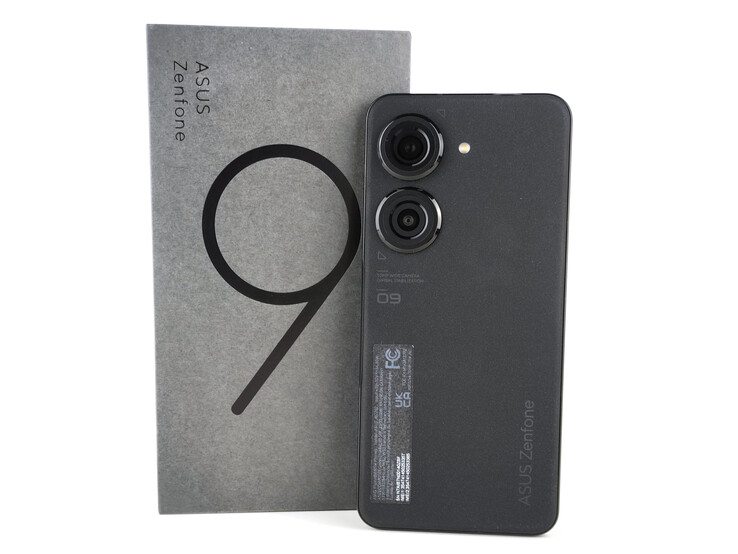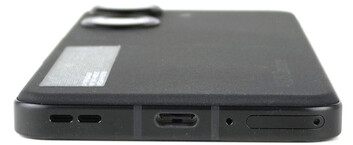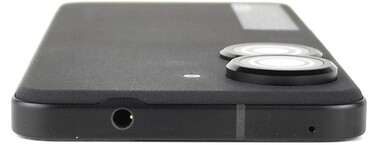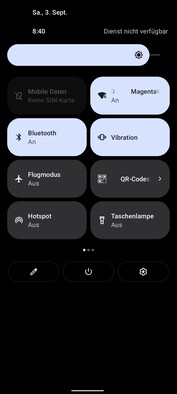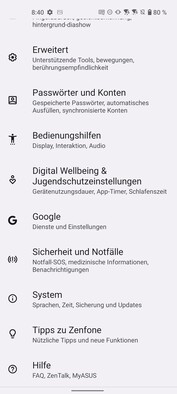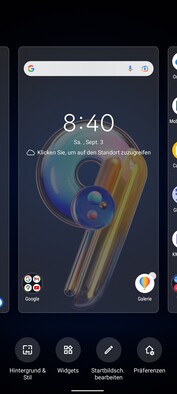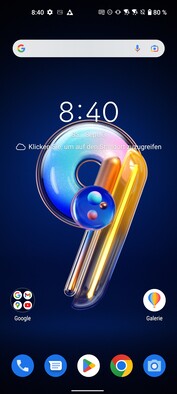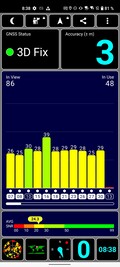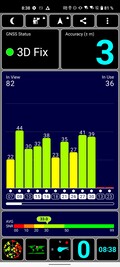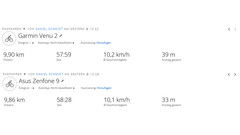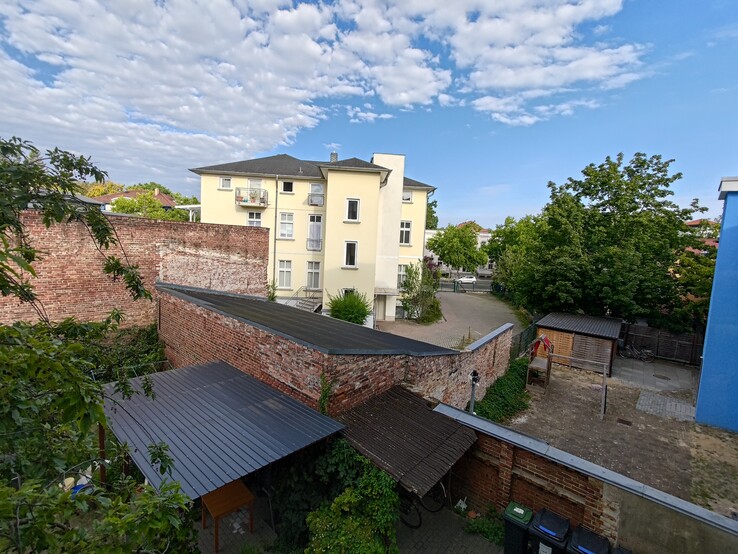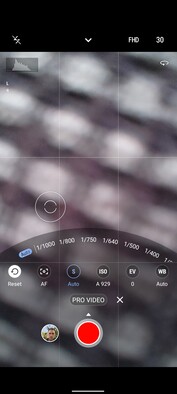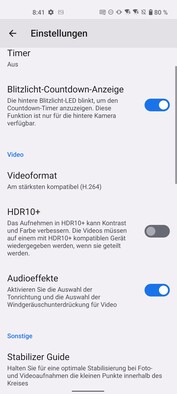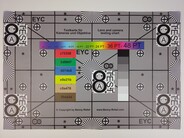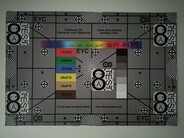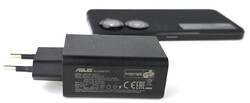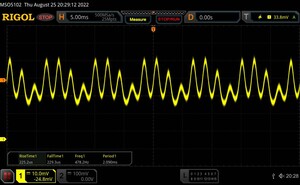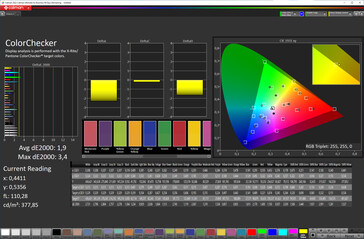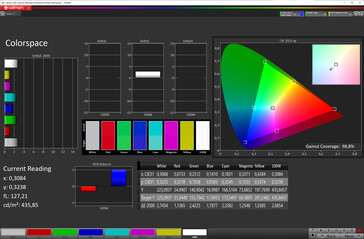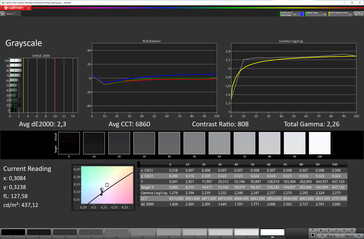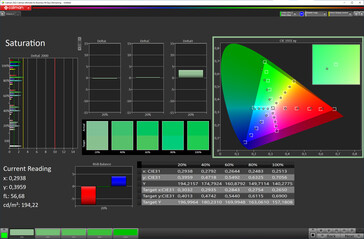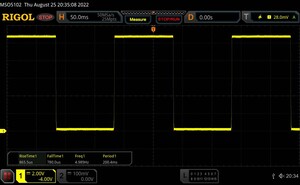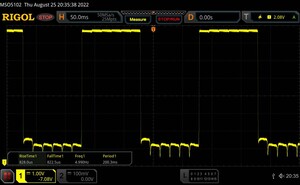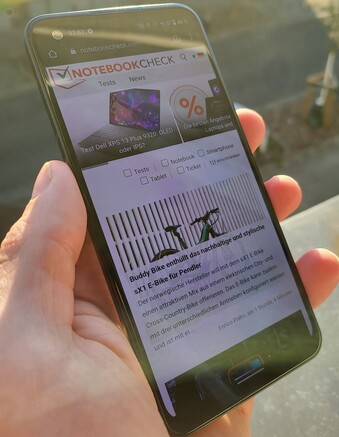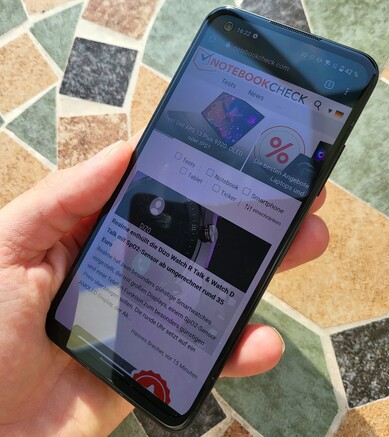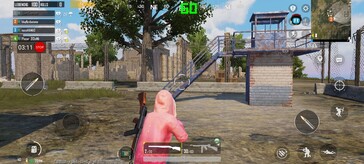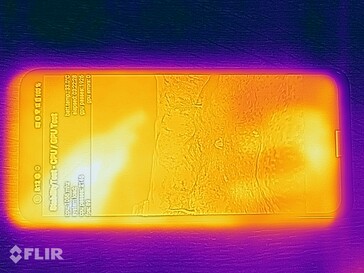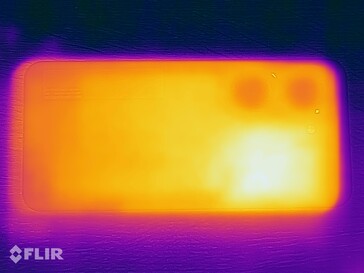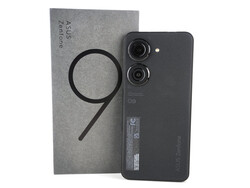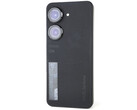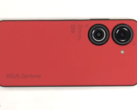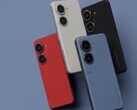Asus Zenfone 9 review - Light 5G smartphone almost without any alternative with its compact size
For those who like compact smartphones, Asus also offers a suitable companion this year. As already in the Zenfone 8, the Taiwanese manufacturer continues to use a 5.9-inch AMOLED panel with a 1080-pixel resolution. However, the refresh rate of the Zenfone 9 display has increased to 120 Hz, and the screen-to-body ratio has also become slightly more efficient.
With the Snapdragon 8+ Gen 1, the compact case of the high-end smartphone houses a flagship SoC, which is accompanied by up to 16 GB of LPDDR5-RAM and a maximum of 256 GB UFS 3.1 storage. The basic version of the Zenfone 9 starts at 8 GB of RAM and 128 GB of storage at an MSRP of 799 Euros (~$801), and the top model with 16 GB of RAM and 256 GB of storage costs 899 Euros (~$901).
On the back, the two large camera lenses stand out. The main camera offers a 50-Megapixel sensor from Sony, which is stabilized with a gimbal OIS system on six axes.
Possible Competitors in Comparison
Rating | Date | Model | Weight | Drive | Size | Resolution | Best Price |
|---|---|---|---|---|---|---|---|
| 88.6 % | 09/2022 | Asus Zenfone 9 SD 8+ Gen 1, Adreno 730 | 169 g | 256 GB UFS 3.1 Flash | 5.90" | 2400x1080 | |
| 87.7 % | 03/2022 | Xiaomi 12 SD 8 Gen 1, Adreno 730 | 179 g | 256 GB UFS 3.1 Flash | 6.28" | 2400x1080 | |
| 89.3 % | 05/2022 | Samsung Galaxy S22 Exynos 2200, Xclipse 920 | 167 g | 128 GB UFS 3.1 Flash | 6.10" | 2340x1080 | |
| 87 % | 08/2022 | OnePlus 10T SD 8+ Gen 1, Adreno 730 | 203.5 g | 256 GB UFS 3.1 Flash | 6.70" | 2412x1080 | |
| 85.6 % | 07/2022 | Nothing Phone (1) SD 778G+ 5G, Adreno 642L | 193.5 g | 256 GB UFS 3.1 Flash | 6.55" | 2400x1080 | |
| 85.9 % | 06/2021 | Asus ZenFone 8 SD 888 5G, Adreno 660 | 169 g | 256 GB UFS 3.1 Flash | 5.92" | 2400x1080 |
Case - Asus smartphone with a punch hole
Weighing just 169 grams (~6 oz) and with a size of 146.5 x 68.1 x 9.1 mm (~5.76 x 2.68 x 0.36 in), the Zenfone 9 is a tad smaller than the Zenfone 8 in all dimensions. In contrast to most representatives of the top end such as the OnePlus 10T, the Asus smartphone is built very compact and conveniently small.
For the back, Asus uses a newly developed structured surface material that is supposed to be extremely resilient, according to the manufacturer. The material, which is available in the four colors Moonlight White, Starry Blue, Sunset Red, and Midnight Black, feels a bit like suede and doesn't show many fingerprints. However, you can have different opinions about the qualitative impression and haptics compared to glass or ceramic materials, in our view. In addition, the surface is hard to clean.
The front of the Asus smartphone is made of a scratchproof Gorilla Glass Victus display glass, which transitions evenly into the metal frame. The surface-to display ratio in front is a solid 84%. For our tastes, the display bezels could have turned out even smaller, though. Compared to the larger competitors, such as the Xiaomi 12 at more than 89%, the Zenfone 9 is clearly surpassed in this regard.
Like its predecessor, the Zenfone 9 also offers an official IP-certification according to the IP68 standard, providing some protection against dust and water. Considering the high-quality workmanship, the overall impression of the high-end smartphone offers no reason for complaint.
Equipment - Zenfone 9 with 3.5-mm audio port
In terms of equipment, the Zenfone 9 offers a dual-speaker system, Bluetooth 5.2, an NFC chip for contactless payment, and a 3.5-mm audio port. The top version with 256 GB of UFS storage that we tested offers 218 GB of available space to the user. In addition, there is dual-SIM functionality, but the card tray, as in its predecessor, doesn't accept microSD cards.
On the other hand, you can connect external peripheral devices such as storage media to the Asus smartphone via the USB-C port. But unfortunately, that still supports only the 2.0 standard. Not only is it significantly slower than that of a Galaxy S22 with USB 3.2, but it also doesn't support wired display output.
Software - Asus smartphone with Android 12
In addition to the compact size, Asus also focusses on optimal one-hand operation in terms of the software. The ZenUI-9 user interface based on Android 12 offers a configurable Edge Tool on the side, providing comfortable quick-access to apps.
The security patches on our test unit are at the level of August 2022 at the time of our testing. There are only supposed to be updates for the first two years after the introduction of the smartphone, so until 2024.
Communication and GNSS - Asus Zenfone 9 with 5G
Within the WLAN at home, the Zenfone 9 offer the fast 802.11ax standard with Wi-Fi 6E, ensuring very high transfer rates in our measurements. However, the 6-GHz frequency band is not recognized in combination with our Asus ROG Rapture GT-AXE11000 reference router. On the other hand, the Asus smartphone also reaches a fast 900 Mbit/s in the 5-GHz frequency range. In addition, the values are very stable.
Besides the fast WLAN, the Zenfone 9 also uses the 5G standard, but without mmWave support. In addition, the compact high-end smartphone offers access to a total of 20 LTE bands, with all the LTE frequencies that are relevant for the German-speaking countries including band 28 being covered.
| Networking | |
| Asus Zenfone 9 | |
| iperf3 receive AXE11000 |
|
| iperf3 transmit AXE11000 |
|
| iperf3 transmit AXE11000 6GHz |
|
| iperf3 receive AXE11000 6GHz |
|
| Xiaomi 12 | |
| iperf3 receive AXE11000 |
|
| iperf3 transmit AXE11000 |
|
| iperf3 transmit AXE11000 6GHz |
|
| iperf3 receive AXE11000 6GHz |
|
| Samsung Galaxy S22 | |
| iperf3 receive AXE11000 |
|
| iperf3 transmit AXE11000 |
|
| OnePlus 10T | |
| iperf3 receive AXE11000 |
|
| iperf3 transmit AXE11000 |
|
| Nothing Phone (1) | |
| iperf3 transmit AXE11000 6GHz |
|
| iperf3 receive AXE11000 6GHz |
|
| Asus ZenFone 8 | |
| iperf3 transmit AX12 |
|
| iperf3 receive AX12 |
|
| Average of class Smartphone | |
| iperf3 receive AXE11000 |
|
| iperf3 transmit AXE11000 |
|
| iperf3 transmit AXE11000 6GHz |
|
| iperf3 receive AXE11000 6GHz |
|
| iperf3 receive AX12 |
|
To determine its location, the Zenfone 9 uses the GPS (L1+L5), GLONASS (G1), BeiDou (B1, B2), and Galileo (E1+E5) satellite systems. In order to evaluate the locating accuracy in practice, we take the Asus smartphone on a little ride, recording the route in parallel with a Garmin Venu 2 for comparison.
The locating capabilities of the Zenfone 9 are mostly convincing. Despite some smaller inaccuracies in the recorded route, the Asus smartphone is very well suited for navigation tasks. We hardly notice any larger deviations from our selected route in the details of the GPS recording.
Telephone Functions and Voice Quality - Asus smartphone with dual-SIM
The Zenfone 9 supports two nano SIM cards as well as the VoLTE standard and WLAN calls, but there is no eSIM. The voice quality is inconspicuous. Voices are reproduced clearly, and our conversation partner also describes them as very clear. With two built-in microphones, the Asus smartphone is also able to score in a video conference - testet via Skype - and with the dual speaker system.
Cameras - Zenfone 9 with dual-camera system
In front, Asus uses a Sony IMX663 with a 12-MP resolution. The selfie camera with autofocus delivers a comfortable sharpness, colors that are rich in contrast, and a good illumination during daylight. The camera, which is hidden underneath a punch hole, records videos in UHD quality at most, which produces great Vlogging results in combination with the phase detection autofocus.
The main camera in the Zenfone 9 is based on the IMX766, a sensor that we already know since it is used in numerous smartphones, such as the OnePlus 10T or Nothing Phone 1. Under good light conditions, the recordings impress with a good sharpness, but the edges are slightly over-sharpened. Overall, the dynamic in the pictures could turn out slightly better. Under low-light conditions, the Asus smartphone quickly hits its limits. Despite a large aperture of f/1.9, the recordings turn out very dark, so that only few details remain. However, thanks to the 6-axis hybrid gimbal technology, the sharpness is satisfactory.
The ultrawide angle lens with a relatively wide viewing angle of 113 degrees offers a decent image quality including a macro function. Although the photos show slightly pale colors, they offer a good basic sharpness and medium level of detail. Since the Zenfone 9 doesn't offer sufficient space for a tele lens, enlargements are solely created digitally. The results are correspondingly weak.
On the other hand, there are hardly any compromises in terms of the video performance. The stabilization of the 50-MP camera is very good for this price class, and in daylight, most movements are compensated by the gimbal technology. In addition, the Pro video mode allows you to adjust many parameters manually. However, you can still see some micro stutters of the Zenfone 9 at night. In addition to UHD recordings (3,840 × 2,160) at 30 frames per second, the main camera also offers an 8K option. While you can switch between the lenses while recording, this is not possible in the Hyper Steady mode.
Image Comparison
Choose a scene and navigate within the first image. One click changes the position on touchscreens. One click on the zoomed-in image opens the original in a new window. The first image shows the scaled photograph of the test device.
WeitwinkelWeitwinkelLow LightUltraweitwinkelZoom 5xWe analyze the color reproduction of the 50-MP lens under controlled light conditions compared to the actual reference colors. Besides the brightening that is typical for smartphones, the Zenfone 9 shows relatively low deviations in the ColorChecker passport. The Asus smartphone doesn't show any high outliers in the color accuracy (>15) at all. On the other hand, the white balance could turn out better.
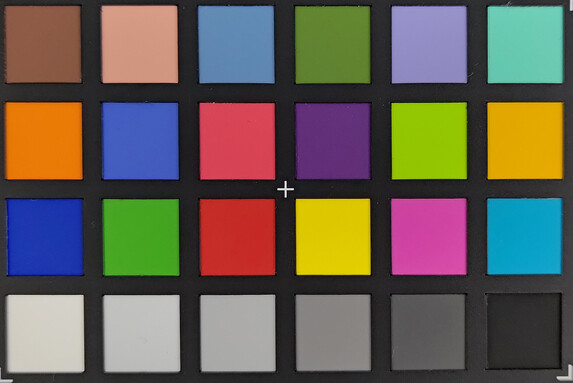

Accessories and Warranty - Asus Zenfone 9 with charger
A modular 30-Watt charger, data/charging cable (USB-C to USB-C), protective cover, SIM tool, and quick start manual together with warranty instructions are included with the Zenfone 9.
Optionally, the manufacturer also offers a special modular Connex case system (MSRP: 50 Euros, ~$50), which in addition to its protective function also offers a connection system for backpacks and a Connex Card holder to keep your ID or credit cards.
Asus offers a 24-month warranty to its smartphone in Germany.
Input Devices and Operation - Asus smartphone with FaceUnlock
Inputs on the 5.9-inch OLED display are recognized accurately up to the corners of the touchscreen. With its scan rate of 240 Hz, the Zenfone 9 panel is checked for touch inputs up to 240 times per second, for example when gaming, ensuring low latencies of touch inputs.
In addition to the compact size, the one-handed operation of the Asus smartphone also benefits from the ZenTouch multi-function key and gesture control on the back. The latter can be triggered by double tapping on the back to start the flashlight function, for example. The central key element on the right case side not only recognizes fingerprints to unlock the display but also offers gesture control, for example to open the notification bar or control the media player.
The integrated, optical fingerprint sensor in the power button unlocks the Zenfone 9 very reliably and also quickly. A fairly insecure 2D face recognition, which is based on a FaceUnlock function via the front camera, is also available.
Display - Asus smartphone with OLED
The Zenfone has a 5.9-inch AMOLED display with a 2,400 x 1,080-pixel resolution that supports a refresh rate of up to 120 Hz. Those who want to save a little power can also configure the display to use 90 Hz or 60 Hz. The Asus smartphone also offers an automatic mode. However, in our test only refresh rates of 60 and 90 Hz are used, but not 120 Hz.
In our brightness measurements, the OLED panel reaches 800 cd/m² with a completely white display, which is satisfactory for this price class. In the APL18 measurement, which is more realistic for everyday operation, it reaches 1,070 cd/m² in the center of the display. This is also a good value, but the Galaxy S22 can still get slightly brighter at 1,296 cd/m².
Due to the OLED panel technology, the Zenfone 9 uses PWM with its display flickering to control the brightness. Below a display brightness of 75%, the PWM frequency varies between 119 and 478 Hz. Up to the maximum brightness, the amplitude becomes more even and constant at 120 Hz. There is also a DC Dimming mode (60 Hz) in the settings. In our temporal dithering test, the behavior of the Zenfone 9 doesn't stand out.
| |||||||||||||||||||||||||
Brightness Distribution: 97 %
Center on Battery: 793 cd/m²
Contrast: ∞:1 (Black: 0 cd/m²)
ΔE Color 1.9 | 0.5-29.43 Ø5
ΔE Greyscale 2.3 | 0.57-98 Ø5.3
98.8% sRGB (Calman 2D)
Gamma: 2.26
| Asus Zenfone 9 AMOLED , 2400x1080, 5.90 | Xiaomi 12 OLED, 2400x1080, 6.28 | Samsung Galaxy S22 AMOLED, 2340x1080, 6.10 | OnePlus 10T Fluid AMOLED, 2412x1080, 6.70 | Nothing Phone (1) OLED, 2400x1080, 6.55 | Asus ZenFone 8 AMOLED, 2400x1080, 5.92 | |
|---|---|---|---|---|---|---|
| Screen | 4% | 6% | -9% | 9% | -12% | |
| Brightness middle | 793 | 867 9% | 853 8% | 861 9% | 620 -22% | 758 -4% |
| Brightness | 796 | 867 9% | 858 8% | 856 8% | 625 -21% | 759 -5% |
| Brightness Distribution | 97 | 98 1% | 96 -1% | 97 0% | 98 1% | 98 1% |
| Black Level * | ||||||
| Colorchecker dE 2000 * | 1.9 | 1.7 11% | 1.9 -0% | 2.27 -19% | 1.24 35% | 3.5 -84% |
| Colorchecker dE 2000 max. * | 3.4 | 4.4 -29% | 3.2 6% | 4.17 -23% | 2.31 32% | |
| Greyscale dE 2000 * | 2.3 | 1.8 22% | 1.9 17% | 2.9 -26% | 1.7 26% | 1.6 30% |
| Gamma | 2.26 97% | 2.2 100% | 2.07 106% | 2.303 96% | 2.318 95% | 2.23 99% |
| CCT | 6860 95% | 6762 96% | 6460 101% | 6141 106% | 6325 103% | 6527 100% |
* ... smaller is better
Screen Flickering / PWM (Pulse-Width Modulation)
| Screen flickering / PWM detected | 478 Hz | ||
The display backlight flickers at 478 Hz (worst case, e.g., utilizing PWM) . The frequency of 478 Hz is relatively high, so most users sensitive to PWM should not notice any flickering. However, there are reports that some users are still sensitive to PWM at 500 Hz and above, so be aware. In comparison: 53 % of all tested devices do not use PWM to dim the display. If PWM was detected, an average of 17915 (minimum: 5 - maximum: 3846000) Hz was measured. | |||
Measurement series at a fixed zoom level with various brightness settings
The high-end smartphone offers 4 color profiles and an "Adjusted" mode where you can adjust the color temperature and intensity. We evaluate the color calibration of the AMOLED panels with the CalMAN analysis software.
In the default settings (profile: Natural), the larger P3 color space is targeted and also covered to a large extent. The DeltaE values that we measure show very low deviations in the colors (<2). We can see some minimal differences in the green and turquoise colors. The reproduction of the Grayscale also shows fairly low deviations that remain within the target range (<3).
Display Response Times
| ↔ Response Time Black to White | ||
|---|---|---|
| 1.65 ms ... rise ↗ and fall ↘ combined | ↗ 0.8655 ms rise | |
| ↘ 0.78 ms fall | ||
| The screen shows very fast response rates in our tests and should be very well suited for fast-paced gaming. In comparison, all tested devices range from 0.1 (minimum) to 240 (maximum) ms. » 5 % of all devices are better. This means that the measured response time is better than the average of all tested devices (21.5 ms). | ||
| ↔ Response Time 50% Grey to 80% Grey | ||
| 1.65 ms ... rise ↗ and fall ↘ combined | ↗ 0.828 ms rise | |
| ↘ 0.8225 ms fall | ||
| The screen shows very fast response rates in our tests and should be very well suited for fast-paced gaming. In comparison, all tested devices range from 0.2 (minimum) to 636 (maximum) ms. » 4 % of all devices are better. This means that the measured response time is better than the average of all tested devices (33.7 ms). | ||
The high-end smartphone shows itself to be very well-equipped for outdoor use in everyday operation. Due to the high brightness and powerful contrasts, the contents always remain sufficiently readable even in direct sunlight. However, you should be aware that the maximum brightness without the brightness sensor is only 446 cd/m² and that reflections on the glass surface should basically be avoided.
Due to OLED technology, the viewing angle stability is very good, and we only notice a loss in brightness from very steep viewing angles. There are hardly any noticeable changes in the colors.
Performance - Zenfone 9 with Qualcomm SoC
Despite the compact dimensions of the Zenfone, Asus uses the powerful Snapdragon 8+ Gen 1 together with 16 GB of LPDDR5-RAM. In our benchmark package, the Qualcomm SoC delivers a very powerful performance, leaving the competitors mostly far behind. Particularly the multi-core result of the Zenfone 9 turns out very high in Geekbench. Even under longer load, the Asus smartphone doesn't report any overheating protection, and all of the benchmarks complete without interruptions.
| UL Procyon AI Inference for Android - Overall Score NNAPI | |
| Asus Zenfone 9 | |
| Average Qualcomm Snapdragon 8+ Gen 1 (3291 - 84787, n=19) | |
| Average of class Smartphone (207 - 84787, n=150, last 2 years) | |
| Nothing Phone (1) | |
| OnePlus 10T | |
In the graphics tests, the Zenfone 9 also delivers a powerful performance with the Adreno 730, but the differences to the OnePlus 10T are lower here, and some of the Snapdragon 8 Gen 1 competitors even end up ahead of the Asus smartphone. This could be connected to the pronounced throttling of the Asus smartphone.
| 3DMark | |
| Wild Life Extreme Unlimited | |
| OnePlus 10T | |
| Asus Zenfone 9 | |
| Xiaomi 12 | |
| Samsung Galaxy S22 | |
| Asus ZenFone 8 | |
| Nothing Phone (1) | |
| Wild Life Extreme | |
| OnePlus 10T | |
| Asus Zenfone 9 | |
| Xiaomi 12 | |
| Samsung Galaxy S22 | |
| Asus ZenFone 8 | |
| Nothing Phone (1) | |
| Wild Life Unlimited Score | |
| Asus Zenfone 9 | |
| OnePlus 10T | |
| Xiaomi 12 | |
| Samsung Galaxy S22 | |
| Asus ZenFone 8 | |
| Nothing Phone (1) | |
| Wild Life Score | |
| Xiaomi 12 | |
| Samsung Galaxy S22 | |
| Asus ZenFone 8 | |
| Nothing Phone (1) | |
| GFXBench (DX / GLBenchmark) 2.7 | |
| T-Rex Onscreen | |
| Xiaomi 12 | |
| Asus Zenfone 9 | |
| Asus ZenFone 8 | |
| Samsung Galaxy S22 | |
| Nothing Phone (1) | |
| OnePlus 10T | |
| 1920x1080 T-Rex Offscreen | |
| OnePlus 10T | |
| Xiaomi 12 | |
| Asus Zenfone 9 | |
| Samsung Galaxy S22 | |
| Asus ZenFone 8 | |
| Nothing Phone (1) | |
| GFXBench 3.0 | |
| on screen Manhattan Onscreen OGL | |
| Xiaomi 12 | |
| Samsung Galaxy S22 | |
| Asus ZenFone 8 | |
| Asus Zenfone 9 | |
| Nothing Phone (1) | |
| OnePlus 10T | |
| 1920x1080 1080p Manhattan Offscreen | |
| OnePlus 10T | |
| Xiaomi 12 | |
| Samsung Galaxy S22 | |
| Asus Zenfone 9 | |
| Asus ZenFone 8 | |
| Nothing Phone (1) | |
| GFXBench 3.1 | |
| on screen Manhattan ES 3.1 Onscreen | |
| Xiaomi 12 | |
| Samsung Galaxy S22 | |
| Asus ZenFone 8 | |
| Asus Zenfone 9 | |
| OnePlus 10T | |
| Nothing Phone (1) | |
| 1920x1080 Manhattan ES 3.1 Offscreen | |
| OnePlus 10T | |
| Xiaomi 12 | |
| Samsung Galaxy S22 | |
| Asus Zenfone 9 | |
| Asus ZenFone 8 | |
| Nothing Phone (1) | |
| GFXBench | |
| on screen Car Chase Onscreen | |
| Xiaomi 12 | |
| Asus Zenfone 9 | |
| Samsung Galaxy S22 | |
| OnePlus 10T | |
| Asus ZenFone 8 | |
| Nothing Phone (1) | |
| 1920x1080 Car Chase Offscreen | |
| OnePlus 10T | |
| Asus Zenfone 9 | |
| Xiaomi 12 | |
| Samsung Galaxy S22 | |
| Asus ZenFone 8 | |
| Nothing Phone (1) | |
| on screen Aztec Ruins High Tier Onscreen | |
| Asus Zenfone 9 | |
| Xiaomi 12 | |
| OnePlus 10T | |
| Samsung Galaxy S22 | |
| Asus ZenFone 8 | |
| Nothing Phone (1) | |
| 2560x1440 Aztec Ruins High Tier Offscreen | |
| OnePlus 10T | |
| Asus Zenfone 9 | |
| Xiaomi 12 | |
| Samsung Galaxy S22 | |
| Asus ZenFone 8 | |
| Nothing Phone (1) | |
| on screen Aztec Ruins Normal Tier Onscreen | |
| Asus Zenfone 9 | |
| Xiaomi 12 | |
| Samsung Galaxy S22 | |
| OnePlus 10T | |
| Asus ZenFone 8 | |
| Nothing Phone (1) | |
| 1920x1080 Aztec Ruins Normal Tier Offscreen | |
| OnePlus 10T | |
| Asus Zenfone 9 | |
| Xiaomi 12 | |
| Samsung Galaxy S22 | |
| Asus ZenFone 8 | |
| Nothing Phone (1) | |
In everyday operation and while browsing, the Asus smartphone leaves an excellent impression. The performance and the benchmark results are first-class. Particularly the short system animations of the ZenUI make the high-end smartphone appear very responsive.
| Jetstream 2 - Total Score | |
| Asus Zenfone 9 (Chrome 104) | |
| Average Qualcomm Snapdragon 8+ Gen 1 (76.2 - 178.5, n=21) | |
| Xiaomi 12 (Chrome 99.0.4844.58) | |
| Average of class Smartphone (13.8 - 351, n=173, last 2 years) | |
| Samsung Galaxy S22 (Chrome 100.0.4896.79) | |
| OnePlus 10T (Chrome 104) | |
| Nothing Phone (1) (Chrome 103) | |
| Speedometer 2.0 - Result | |
| Average Qualcomm Snapdragon 8+ Gen 1 (69.1 - 167, n=16) | |
| Samsung Galaxy S22 (Chrome 100.0.4896.79) | |
| Average of class Smartphone (14.9 - 445, n=157, last 2 years) | |
| Xiaomi 12 (Chrome 99.0.4844.58) | |
| Asus Zenfone 9 | |
| OnePlus 10T (Chrome 104) | |
| Nothing Phone (1) (Chome 103) | |
| WebXPRT 3 - Overall | |
| Asus Zenfone 9 (Chrome 104) | |
| Average Qualcomm Snapdragon 8+ Gen 1 (106 - 224, n=14) | |
| Asus ZenFone 8 (Chrome 90) | |
| Samsung Galaxy S22 (Chrome 100.0.4896.79) | |
| Xiaomi 12 (Chrome 99.0.4844.58) | |
| Average of class Smartphone (39 - 304, n=122, last 2 years) | |
| OnePlus 10T (Chrome 104) | |
| Nothing Phone (1) (Chrome 103) | |
| Octane V2 - Total Score | |
| Asus Zenfone 9 (Chrome 104) | |
| Average Qualcomm Snapdragon 8+ Gen 1 (17622 - 55611, n=22) | |
| OnePlus 10T (Chrome 104) | |
| Samsung Galaxy S22 (Chrome 100.0.4896.79) | |
| Asus ZenFone 8 (Chrome 90) | |
| Xiaomi 12 (Chrome 99.0.4844.58) | |
| Average of class Smartphone (4633 - 89112, n=211, last 2 years) | |
| Nothing Phone (1) (Chrome 103) | |
| Mozilla Kraken 1.1 - Total | |
| Nothing Phone (1) (Chrome 103) | |
| OnePlus 10T (Chrome 104) | |
| Average of class Smartphone (388 - 9999, n=173, last 2 years) | |
| Samsung Galaxy S22 (Chrome 100.0.4896.79) | |
| Asus ZenFone 8 (Chrome 90) | |
| Average Qualcomm Snapdragon 8+ Gen 1 (729 - 1707, n=20) | |
| Xiaomi 12 (Chrome 99.0.4844.58) | |
| Asus Zenfone 9 (Chrome 104) | |
* ... smaller is better
The 256-GB UFS storage in the Zenfone 9 delivers high read and write rates. At almost 1,800 Mbit/s the write speed is really powerful.
| Asus Zenfone 9 | Xiaomi 12 | Samsung Galaxy S22 | OnePlus 10T | Nothing Phone (1) | Asus ZenFone 8 | Average 256 GB UFS 3.1 Flash | Average of class Smartphone | |
|---|---|---|---|---|---|---|---|---|
| AndroBench 3-5 | -2% | -28% | -41% | -26% | -25% | -19% | -28% | |
| Sequential Read 256KB | 1986.97 | 1851 -7% | 1486 -25% | 1568.37 -21% | 1638 -18% | 1781 -10% | 1760 ? -11% | 1505 ? -24% |
| Sequential Write 256KB | 1776.21 | 1417 -20% | 993 -44% | 847.69 -52% | 1351.9 -24% | 767 -57% | 1134 ? -36% | 1112 ? -37% |
| Random Read 4KB | 298.46 | 325.2 9% | 273 -9% | 173.45 -42% | 240.6 -19% | 292.3 -2% | 281 ? -6% | 247 ? -17% |
| Random Write 4KB | 398.39 | 437.5 10% | 257.6 -35% | 211.24 -47% | 228.2 -43% | 272.9 -31% | 311 ? -22% | 271 ? -32% |
Games - Asus Zenfone 9 reaches 120 fps
We evaluate the gaming capabilities of the compact high-end smartphones using the application of our partner GameBench, also recording the exact frame rates per second.
PUBG Mobile runs nice and smooth. Up to the HD setting, 60 fps are possible, and the Zenfone 9 reaches stable 40 fps with the UHD option. The frame rates in Armajet turn out similarly attractive. The Asus reaches 110 frames per second here, which is significantly more than the Xiaomi 12 or Galaxy S22.
Emissions - Asus smartphone only warms up to a limited extent
Temperatures
The surface temperatures of the case are relatively low for a smartphone with the Snapdragon 8+ Gen1, even under load. Particularly considering the compact build, the Zenfone 9 produces relatively low heat, but this also goes to the detriment of the performance.
The high-end smartphone completes the battery tests of GFXBench without any interruptions, even the demanding Manhattan Test (OpenGL ES 3.1), although we are unable to evaluate that. The Wild Life stress tests of 3DMark also complete without any problems, but the Qualcomm SoC is throttled noticeably here. At about 50%, the Zenfone 9 is significantly less constant than the predecessor. On the other hand, other smartphones with the Snapdragon 8+ Gen1, such as the Xiaomi 12S Pro, have similar thermal problems, also reducing their performance correspondingly.
(+) The maximum temperature on the upper side is 35.1 °C / 95 F, compared to the average of 35 °C / 95 F, ranging from 21.9 to 56 °C for the class Smartphone.
(+) The bottom heats up to a maximum of 35 °C / 95 F, compared to the average of 33.8 °C / 93 F
(+) In idle usage, the average temperature for the upper side is 28.3 °C / 83 F, compared to the device average of 32.7 °C / 91 F.
3DMark Wild Life Stress Test
| 3DMark | |
| Wild Life Stress Test Stability | |
| Nothing Phone (1) | |
| OnePlus 10T | |
| Asus ZenFone 8 | |
| Samsung Galaxy S22 | |
| Asus Zenfone 9 | |
| Xiaomi 12 | |
| Wild Life Extreme Stress Test | |
| Nothing Phone (1) | |
| Asus ZenFone 8 | |
| Samsung Galaxy S22 | |
| Asus Zenfone 9 | |
| Xiaomi 12 | |
| OnePlus 10T | |
Speakers
In terms of audio, the Zenfone 9 stands out with good stereo speakers, a wide selection of supported Bluetooth codecs including LDAC, aptX HD, and aptX Adaptive, and a 3.5-mm audio port including Qualcomm's Aqstic WCD9380 DAC. The latter shows a very low noise level in our test (SNR: 98.6 dBFS).
The two speakers produce a high maximum volume of 88 dB and a full sound. On the other hand, both the mids and highs could have turned out slightly more linear. The superhigh frequencies also drop significantly in the Zenfone 9.
Asus Zenfone 9 audio analysis
(+) | speakers can play relatively loud (88 dB)
Bass 100 - 315 Hz
(-) | nearly no bass - on average 19.9% lower than median
(±) | linearity of bass is average (8.8% delta to prev. frequency)
Mids 400 - 2000 Hz
(±) | higher mids - on average 5.5% higher than median
(+) | mids are linear (4.7% delta to prev. frequency)
Highs 2 - 16 kHz
(±) | higher highs - on average 8.1% higher than median
(+) | highs are linear (3.4% delta to prev. frequency)
Overall 100 - 16.000 Hz
(±) | linearity of overall sound is average (18.8% difference to median)
Compared to same class
» 16% of all tested devices in this class were better, 9% similar, 75% worse
» The best had a delta of 12%, average was 38%, worst was 134%
Compared to all devices tested
» 38% of all tested devices were better, 8% similar, 54% worse
» The best had a delta of 4%, average was 25%, worst was 134%
Samsung Galaxy S22 audio analysis
(+) | speakers can play relatively loud (89.5 dB)
Bass 100 - 315 Hz
(-) | nearly no bass - on average 26.3% lower than median
(±) | linearity of bass is average (10.2% delta to prev. frequency)
Mids 400 - 2000 Hz
(±) | higher mids - on average 6.2% higher than median
(+) | mids are linear (4.4% delta to prev. frequency)
Highs 2 - 16 kHz
(±) | higher highs - on average 5.6% higher than median
(+) | highs are linear (5.5% delta to prev. frequency)
Overall 100 - 16.000 Hz
(±) | linearity of overall sound is average (19% difference to median)
Compared to same class
» 18% of all tested devices in this class were better, 9% similar, 73% worse
» The best had a delta of 12%, average was 38%, worst was 134%
Compared to all devices tested
» 39% of all tested devices were better, 8% similar, 53% worse
» The best had a delta of 4%, average was 25%, worst was 134%
Battery Life - Zenfone 9 with Quick Charge 4.0
Power Consumption
The battery of the Asus smartphone offers a capacity of 4,300 mAh and can be recharged at a rated performance of 30 watts with Quick Charge technology in about 85 minutes. Fortunately, the corresponding charger is included with the Zenfone 9. Wireless charging, on the other hand, is missing.
Compared to the consumption of the OnePlus 10T and considering the significantly smaller OLED panel, the power consumption is slightly high. Particularly in Geekbench at an adjusted brightness of 150 cd/m², the Asus smartphone consumes a relatively high amount of power.
| Off / Standby | |
| Idle | |
| Load |
|
| Asus Zenfone 9 4300 mAh | Xiaomi 12 4500 mAh | Samsung Galaxy S22 3700 mAh | OnePlus 10T 4800 mAh | Nothing Phone (1) 4500 mAh | Asus ZenFone 8 4000 mAh | Average Qualcomm Snapdragon 8+ Gen 1 | Average of class Smartphone | |
|---|---|---|---|---|---|---|---|---|
| Power Consumption | -27% | -21% | 4% | -11% | 1% | -45% | -27% | |
| Idle Minimum * | 1.01 | 0.87 14% | 0.69 32% | 0.8 21% | 1 1% | 0.82 19% | 1.015 ? -0% | 0.897 ? 11% |
| Idle Average * | 1.1 | 1.7 -55% | 1.19 -8% | 1.2 -9% | 1.2 -9% | 1.1 -0% | 1.869 ? -70% | 1.452 ? -32% |
| Idle Maximum * | 1.17 | 1.82 -56% | 1.26 -8% | 1.3 -11% | 1.5 -28% | 1.16 1% | 2.02 ? -73% | 1.629 ? -39% |
| Load Average * | 3.3 | 4.68 -42% | 6.97 -111% | 3.5 -6% | 4.2 -27% | 4.24 -28% | 5.69 ? -72% | 5.55 ? -68% |
| Load Maximum * | 7.89 | 7.41 6% | 8.85 -12% | 5.9 25% | 7.4 6% | 6.83 13% | 8.55 ? -8% | 8.31 ? -5% |
* ... smaller is better
Poser Consumption: Geekbench (150 cd/m²)
Poser Consumption: GFXBench (150 cd/m²)
Battery Life
In our realistic battery tests that are run at an adjusted display brightness of 150 cd/m² and are therefore easily comparable, the 4,300-mAh battery achieves good runtimes at a fixed refresh rate of 120 Hz. In our WLAN test, the Zenfone lasts for almost 14 hours, and in the constant video loop with the WLAN module deactivated, even 10 hours more are possible.
| Asus Zenfone 9 4300 mAh | Xiaomi 12 4500 mAh | Samsung Galaxy S22 3700 mAh | OnePlus 10T 4800 mAh | Nothing Phone (1) 4500 mAh | Asus ZenFone 8 4000 mAh | |
|---|---|---|---|---|---|---|
| Battery Runtime | -2% | -14% | 0% | -12% | -46% | |
| Reader / Idle | 1685 | 2558 52% | 2182 29% | 1795 7% | 1813 8% | |
| H.264 | 1401 | 890 -36% | 887 -37% | 1646 17% | 1059 -24% | |
| WiFi v1.3 | 825 | 760 -8% | 675 -18% | 856 4% | 926 12% | 442 -46% |
| Load | 462 | 385 -17% | 324 -30% | 332 -28% | 259 -44% |
Pros
Cons
Verdict on the Asus Zenfone 9
With its compact dimensions, the Zenfone 9 is one of the most interesting smartphones also in this year for those who like small phones. Fortunately, the 2022 model has remedied the largest problem of its predecessor, which was its bad battery life.
Despite its compactness, there are hardly any compromises compared to the noticeably larger high-end competitors. Particularly the gimbal technology makes the Asus smartphone special, also since the Taiwanese manufacturer combines this technology with the main camera, offering a real additional value in everyday operation. Video recordings are very well stabilized by the Zenfone 9, particularly in daylight. The compact smartphone is slightly weaker in dark light conditions, also in the area of photography.
The Zenfone 9 is a powerful upgrade compared to the predecessor. It is unfortunate that Asus will probably only deliver two large Android updates to its compact smartphone.
Despite its small size, the Zenfone 9 doesn't have to forego a flagship SoC, even though without the corresponding throttling, it would create too much heat, similar to the Xiaomi 12S Pro. Those who want to be able to constantly use the full power of the Snapdragon 8+ Gen1 can take a look at the ROG Phone 6 (Pro) sibling model with active cooling.
Besides the Samsung Galaxy S22 and Xiaomi 12 from the Android segments, another alternative would be the Apple iPhone 13 Mini.
Price and Availability
The Asus Zenfone 9 is available unlocked from Amazon starting from $705, for example.
Asus Zenfone 9
-
09/12/2022 v7
Marcus Herbrich


 Deutsch
Deutsch English
English Español
Español Français
Français Italiano
Italiano Nederlands
Nederlands Polski
Polski Português
Português Русский
Русский Türkçe
Türkçe Svenska
Svenska Chinese
Chinese Magyar
Magyar